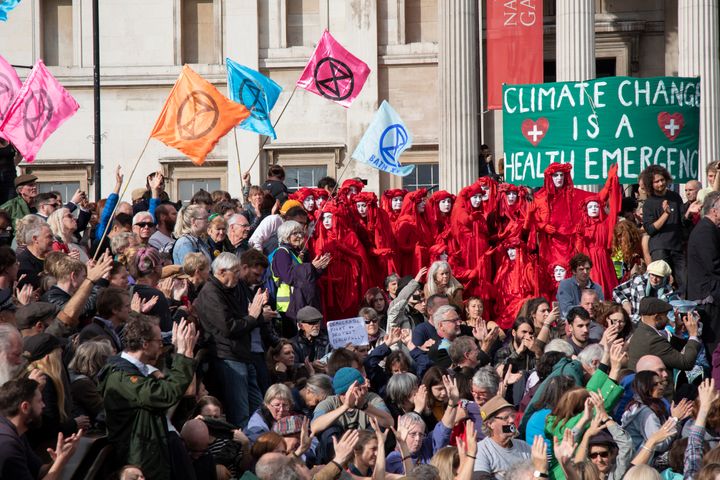Thursday’s action in which climate change activists affiliated with Extinction Rebellion targeted the London Underground and DLR service is causing members of the group to reconsider the group’s strategy.
During the start of the rush-hour commute on Thursday, activists glued themselves to train doors and stood atop carriages at Stratford, Canning Town and Shadwell stations in East London.
Inconvenienced passengers reacted with anger. Videos posted to social media showed the crowd at one station hurling bottles at a protester who stood atop a train and then dragging him down onto the station platform.
The action marks something of a turning point in the climate change protests, which have taken place across London over the past two weeks. Whereas earlier actions targeted lawmakers and financial institutions, the strategy of inconveniencing commuters was questioned by many supporters as a step too far.

On LBC Thursday morning, Fergal McEntree, one of Extinction Rebellion’s co-founders, called the Tube protest a “huge own goal.”
“Public support for this isn’t going to be very good,” he said.
Asked whether he would have condoned the Tube protest, McEntree said, “No, I wouldn’t have.”
Members of Extinction Rebellion who planned to protest at Gatwick Airport on Thursday decided to postpone their action, telling a reporter that they were overwhelmingly opposed to the Tube protests. (Though a smaller group of protesters later decided to hand out leaflets at the airport.) And in online forums, members of the group also expressed their frustrations.
“It was disappointing to see the affinity groups go ahead knowing that most members were opposed,” Martha Henson, a member of the group based in London, told HuffPost UK.
“What happened this morning is going to be a huge point of discussion within the group, and I think we’ve learnt a lot from it.”
Another Extinction Rebellion member based in Bristol, who asked not to be identified, agreed with the sentiment.
“I don’t think targeting public transport, especially in a working-class area and at a time which really impacted normal people just trying to get to work, was a particularly good decision,” she said. “When it was discussed, most members agreed it probably wouldn’t send the right message.”
In a statement Thursday afternoon, Extinction Rebellion expressed “sadness” over the violence in connection with the Tube protest.
“It is regretful that there was violence at today’s action at Canning Town tube station. We would like to express our sadness that events escalated this way,” the group said.
“In light of today’s events, Extinction Rebellion will be looking at ways to bring people together rather than create an unnecessary division.”
Howard Rees, an Extinction Rebellion spokesperson, defended the Tube action, telling PA Media that while “it is not our intention to target individuals or inconvenience hard-working people,” the dire nature of the climate crisis justified extreme action. “We’re in a life or death situation right now,” he said.
Still, he acknowledged that the Tube protests may have been a misstep. “Was it the right thing to do? I am not sure,” he told PA Media.
“I think we will have to have a period of reflection. It is too early to say. I think we need to take stock of it.”
According to Joel Scott-Halkes, another Extinction Rebellion spokesperson, a “guardian team”, which ensures that the group’s principles are adhered to, would be reviewing the action to determine whether the group’s rules had been broken.
The investigation, he said, would look specifically at whether one activist’s actions – which the group described as “self defence in a moment of panic when confronted by a threatening situation” – adhered to the group’s commitment to non-violence.
“The action that took place this morning is going to be discussed as to whether any part of it did breach the non-violence principle,”Scott-Halkes said. “There was seemingly footage of a protestor acting in self defence.
“It’s possible that the central guardian team may condemn that part of the action. But that process is not going to be rushed into, that thought process of listening and de-briefing, and thinking about controversial actions like this, will take days or weeks.”
Differing opinions on strategy are somewhat inevitable, given Extinction Rebellion’s organisational structure.
The group is based on the idea of “autonomy and decentralisation”, with each Extinction Rebellion group functioning as its own independent unit.
This means that “affinity groups”, such as the one that targeted the London transport system on Thursday, are free to protest and identify as Extinction Rebellion protesters however they like, as long as they adhere to the group’s main principles.
